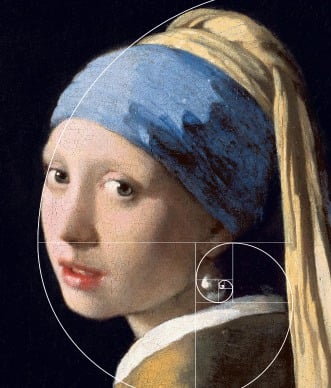In the annals of art history, there are a handful of paintings that have achieved iconic status, combining wide admiration with pop-cultural familiarity. Renaissance works like Leonardo da Vinci’s Mona Lisa, Botticelli’s Birth of Venus, and Michelangelo’s Creation of Adam fit in this category, as do modern “icons” like Vincent van Gogh’s Starry Night or Edvard Munch’s angsty The Scream. Many of these paintings have epic subject matter, larger-than-life personalities, or dramatic events informing them, and this adds to their fame. The picture becomes a stand-in for a larger story.
 Starry Night by Vincent van Gogh / Public domain via Wikimedia Commons
Starry Night by Vincent van Gogh / Public domain via Wikimedia Commons
But there is one “iconic” painting that fits none of these categories. Johannes Vermeer’s Girl With a Pearl Earring was never the victim of a spectacular art theft like the Mona Lisa. Vermeer himself was not a volatile, tormented figure like van Gogh or Munch but rather a dutiful and pious family man. Meanwhile, Girl with a Pearl Earring’s subject matter, inscribed right in the title, is humble and mysterious, with no obvious narrative and no famous historical connection. On top of all this, neither Vermeer nor his painting received any “press” back in the 1600s. Far from being a self-promoter, Vermeer kept to himself and worked under the radar. At the time of his death, he had little reputation outside his hometown.
 The only supposed portrait of Jan Vermeer in The Procuress / Public domain via Wikimedia Commons
The only supposed portrait of Jan Vermeer in The Procuress / Public domain via Wikimedia Commons
Nevertheless, Vermeer’s Girl with A Pearl Earring is today widely beloved and well-known. Why? Because of its beauty. In the centuries following Vermeer’s death, enthralled by the beauty of his work, appreciative art critics kept the legacy of this quiet, fastidious painter alive. Finally, by the early 20th century, an almost cult-like devotion had emerged around Vermeer’s ravishing figures—not to mention a booming market in forgeries.
What is Beauty?
But how do we explain the visual appeal—the beauty—of something like Girl with a Pearl Earring? Is it naïve to assume that there is even such a thing as “absolute beauty”?
In recent years, it has become fashionable to explain our aesthetic responses—and the standards that seem to inform them—as mere cultural constructs that are learned for purely social reasons and that, consequently, can be unlearned in the pursuit of greater open-mindedness. In the art world, historians and curators often take care to avoid speaking of aesthetic value, preferring instead to discuss artworks as aesthetically neutral records of experience.
It is undeniable, however, that many of us still speak the language of beauty and still regard certain objects as exceptionally beautiful, no matter the social framework. Tourists who flock to objects like Girl with a Pearl Earring—tourists from all over the world—earnestly attest to a visual charm that can bring tears to one’s eyes. It seems, in fact, that pure beauty is one of the few things that can unite us across cultural divides, giving us common objects of admiration despite conflicting worldviews, political differences, and historical enmity. I think the medieval philosopher Thomas Aquinas can help us understand why.
Thomas Aquinas, Girl with a Pearl Earring, and Beauty
According to Thomas Aquinas, a Dominican monk of the 13th century, the objects we regard as most beautiful are objects that share in the dynamics of God’s creation; in other words, the most beautiful human-made objects are those that most closely emulate God’s creativity in the natural world, “unfurling,” so to speak in the same way, natural objects grow and unfurl. In the twentieth century, Aquinas’s aesthetic theory was fleshed out by thinkers like the philosopher Etienne Gilson, who mapped Aquinas’s ideas onto developments in modern art.
Thomas Aquinas by Sandro Botticelli / Public domain via Wikimedia Commons
For thinkers like Aquinas and Gilson, beautiful objects can express God’s creative dynamism in two ways: first, they can faithfully copy the appearance of nature, which is intrinsically beautiful, especially when it is in a state of health and flourishing. But second and most importantly, their making can actually participate in the creative principles of nature, which join individual living things into ecosystems of marvelous fruitfulness and complementarity. Thomas Aquinas labeled qualities stemming from these principles harmony, integrity, and luminosity. The Girl with the Pearl Earring has all three. Here’s how.
Harmony in Girl With a Pearl Earring
It is well known that certain formal patterns often occur in nature and are generally perceived as beautiful to the human eye. Fractal forms, which consist of similar shapes being repeated across various sizes and scales, account for the pleasure we find in looking at magnified snowflakes, rippling water, spiraling seashells, and complex swirls of leaves and flowers. The repetition of forms across larger and smaller scales creates feelings of resonance and “matching” that evoke cooperation, oneness, and harmony. The so-called “golden ratio” is a mathematical constant found throughout nature that helps explain the way congruent or “matching” forms are related to each other across scales from the very small to the very large. Unsurprisingly, Johannes Vermeer’s Girl With a Pearl Earring makes extensive use of the golden ratio, employing proportions that unfold in a “golden spiral” outward from the center of the painting.
 A Girl with a Pearl Earring by Johannes Vermeer with an overlay of the Fibonacci spiral exhibiting the "golden ratio" / Painting in Public domain and Fibonacci spiral under CC BY-SA 4.0 via Wikimedia Commons
A Girl with a Pearl Earring by Johannes Vermeer with an overlay of the Fibonacci spiral exhibiting the "golden ratio" / Painting in Public domain and Fibonacci spiral under CC BY-SA 4.0 via Wikimedia Commons
Integrity in Girl With a Pearl Earring
An object with integrity feels like a completed whole. It is satisfying. One doesn’t feel a need to embellish it or bring its parts into balance because it is already balanced, stable, and “finished.” Horror movie designers know that one of the easiest ways to make something “scary” is to mar its integrity—to make it feel unfinished or unfulfilled. (I think of the “Pale Man” in Alfonso Cuaron’s Pan’s Labyrinth, with its missing eyes.) An object with integrity lacks nothing needful; it has all it needs to “survive.” And this very completeness makes it throb with vigor and life. The Girl With a Pearl Earring is an exquisitely balanced work that feels complete—in fact, it feels larger than itself. The artist’s use of volume and light suggests a “fully-fleshed,” beautifully proportioned organism that inhabits its own space in the world beyond the confines of the picture plane.
Luminosity in Girl With a Pearl Earring
This is the most elusive of Aquinas’s categories. The word itself can be related to luster, glow or shine, but that’s not entirely what Aquinas meant. According to Etienne Gilson, Aquinas’s “luminosity” can be equated to “ensouled-ness.” This quality is hard to account for with purely visual cues like quantities and measurements; it’s almost something that one must access purely through empathy or spiritual resonance. But its power is undeniable. A “luminous” work is one that radiates spiritual presence despite the fact that one knows it’s merely paint and canvas. For many viewers, the Girl with a Pearl Earring has exactly that kind of soulful charge.
Beauty, Nature, and the Handmade
None of the properties above—harmony, integrity, and luminosity—are limited to the realm of art or even originate in it. Rather, they are all natural qualities shared by all living things, and it is the artist’s job to capture them. They seem, in fact, to be part of the creative vocabulary of the universe as created and sustained by God. Artificial products that share these principles appear beautiful precisely because they seem to have emerged from natural processes. And they bear witness to the fact that artists, like all of us, are especially “created in the image of God” as makers.
 A Girl with a Pearl Earring by Johannes Vermeer / Public domain via Wikimedia Commons
A Girl with a Pearl Earring by Johannes Vermeer / Public domain via Wikimedia Commons
Interestingly, then, the artworks we most widely celebrate as beautiful are not, generally, “photorealistic.” The photograph is not produced according to the creative principles of nature; instead, it is a momentary “slice,” or cross-section, of something much richer than the photograph can capture. In this sense, the bare photograph is comparatively reductive and violent. Yes, it captures an appearance, but (in its simplest form) this appearance is almost surgically extracted from a living object that has become “frozen” by a mechanical process. What does this mean for us? Have we lost sight of true beauty because our visual culture is so heavily mediated by mechanical processes and not by human hands flowing with the creative dynamism of God?
Johannes Vermeer was an artist intuitively gifted to “flow” with God’s creation. He was also a Catholic convert in a region with strong anti-Catholic sentiment who worked hard to stay rooted in his faith. It’s impossible to know what the humble Vermeer read and studied during his short life, but perhaps he was attuned to the aesthetics of Thomas Aquinas, by then a towering Catholic saint.

